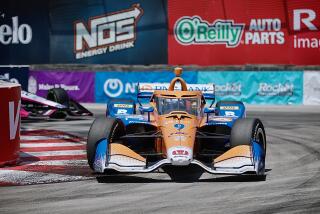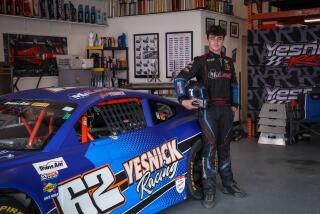Race car drifting: There’s nothing like screaming sideways at 90 mph
The tires on Vaughn Gittin Jr.’s Ford Mustang are shrieking as he jerks his car sideways at nearly 90 mph on this serpentine race track in Long Beach.
Walls are closing in on either side, leaving no room for mistakes.
As the next turn nears, Gittin pumps the clutch and yanks a neon green hand brake. The rear wheels lose traction, sending the car into a power slide and unleashing a torrent of smoke into the packed grandstands.
The move brings nearly 15,000 spectators to their feet. This is what they came to see: drifting.
What began as an illegal hobby in Southland parking lots has grown into a multimillion-dollar motor sport appealing to a new generation. The Formula Drift series opened its 10th season last weekend on city streets near the Long Beach Arena. Saturday night, 16 drivers will conduct an encore performance at the Toyota Grand Prix of Long Beach.
“In the 39 years of the Grand Prix, no event has ever taken place at night,” said Jim Liaw, president and co-founder of Formula Drift. “This is the big time. We’re not just guys tearing up asphalt in parking lots anymore.”
Indeed. Last week’s two-day event took in 20,000 visitors who each paid $27 to $37 for admission, and more are expected at the turnstiles this weekend.
Drifting has nothing to do with racing. There’s no checkered flag. It’s more like figure skating than speed skating, with a three-judge panel awarding points based on speed, angle of attack and style.
They take points away for going off course, stalling or running into course markers — including walls. And for driving straight: The goal is to control the car as it slides sideways around turns, as if on ice, at full throttle.
Drift cars get beaten like rented mules. Drivers run them into walls, blow up their turbochargers, snap their axles. Tires get shredded and tossed like dirty hankies.
But the drivers seem to hold up pretty well; there has never been a fatality at an organized drift event.
The events take place over two days. On Fridays, drivers make solo runs around the track to qualify for the next round. On Saturdays, the top 32 drivers take to the track in tandem runs in which the two cars are door to door — mere inches apart.
In tandem runs, one is designated a lead car. The chase car must follow its driving line as closely as possible. Then they alternate.
Lead cars try to create a gap. Or they try to block the chase car, to force it off course.
Legend has it that drifting started in the 1960s in the snowy mountains of Japan, where drivers would slide cars through tight turns. In time, it found its way into Japanese motor sports when racers would speed into the apex of a corner, then drift through it rather than brake.
Eventually, drifting found its way to the U.S. and into Southern California’s car culture.
Rear-wheel-drive cars are essential. Japanese imports are often favorites, such as the Nissan 240SX and 350Z, the Mazda RX-7 and older Toyota Corollas. Much like in the hot-rod generation, car shops across the Southland churn out parts that enable drifting enthusiasts to burn rubber at ever-increasing speeds.
The sport has brought an influx of business to makers of go-fast parts.
“It was once considered a fad,” said Specialty Equipment Market Assn. spokesman Peter MacGillivray. “Not anymore.”
Tire manufacturers dig it the most. Nitto Tire U.S.A. Inc., based in Cypress, sponsors three Formula Drift drivers — each of whom shredded about 20 tires last weekend.
Detroit automakers have taken notice as well, sponsoring several drivers. They see it as a way to connect with future consumers, a younger generation more inclined to watch a three-minute drift tandem than a three-hour NASCAR race.
Once rarities in competition, Dodge Vipers and Chevrolet Camaros are commonplace. The Ford Mustang has also been increasingly popular in drifting because of drivers like Gittin.
The 32-year-old native of Joppa, Md., started drifting as a weekend hobby. In the early 2000s, after getting off his shift as an IT professional in Arlington, Va., Gittin would pack his Nissan 240SX full of tires and drive 3 1/2 hours to New Jersey, where he’d compete in the same car, his daily driver.
Today, his Mustang RTR — all 845 horsepower of it, painted black and neon green — is waiting for him when he shows up to an event. He’s sponsored by Monster Energy Drink.
“One thing about this sport is that power is unlimited,” Gittin said. “But don’t get it wrong. I’ve been beaten by guys with four-cylinders.”
Kenshiro Gushi, 26, drives a turbocharged four-banger Scion FR-S for GReddy Racing. He learned drifting from his father, who moved the family to San Gabriel from Okinawa, Japan, when he was a baby.
By 13, Gushi was drifting on the dry lakes in a 1986 Toyota Corolla. Two years later, he was caught drifting in the City of Industry. A year later, it happened again, so Gushi was promptly suspended from getting a driver’s license until he was 21.
“In those days, events would take place in a parking lot,” Gushi said. “We’d drift one corner at a time.”
There will be seven Formula Drift events nationwide this year, as well as others in Indonesia, Malaysia and Australia.
When the “Fast and the Furious” movie franchise came out with “Tokyo Drift” in 2006, it raised the profile of the sport in the U.S., grabbing younger audiences.
Last week in Long Beach, hip-hop music blared to a crowd of people in their 20s and 30s.
One was 23-year-old David Koh, a student from Corona, who has slapped a turbocharger on his 1993 Nissan 240SX and drifts in empty parking lots.
“It’s cool to see the pros do it,” he said at the event. “I’d do it more if I could, but I need money for new tires.”







